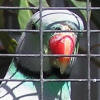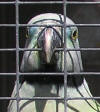. Malabar parrot



Aviary Notes: Level Of Knowledge Required: Beginner / Intermediate / Advanced / Specialist Breeders Only. Government Regulations & By-Laws: Refer to " Government Laws " web page. Housing Requirements: Refer to " Housing Birds " web page for general details on the housing of Non Australian Parrots or read on for specific details for this parrot. One pair per aviary. Not suitable for a mixed species collection. Minimum aviary size should be no less than 2 metres long. An aviary of about 3 metres long and 1 metre wide (10 ft x 3.5 ft) is preferable. Aviary can be up to 5 metres (16 ft) long. Construction should be a steel frame with heavy duty wire netting. They love to chew on timber. The Malabar Parrot can be housed and bred in a suspended cage. Access to a conventional aviary during the non breeding season will allow these birds to regain optimal fitness prior to the next breeding season. Plenty of exercise minimizes the risk of birds becoming overweight or obese. Non-toxic leafy branches can be placed in the aviary for the birds to chew up. This will entertain the birds, help minimize boredom and give the birds some beak exercise. Natural branches can be used for perches. These natural perches will be chewed by the birds and may need to be replaced regularly. The birds will chew any flowers and fruiting bodies on the branches. Diet / Feeding: Refer to " Feeding Birds " web page for general details on the feeding of Non Australian Parrots or read on for specific details for this parrot. Natural diet includes seeds, fruits, berries, nuts and some flower and leaf buds. May obtain some nectar or pollen from flowers. Will obtain some food items from orchards and other cultivated areas. Aviary diet include a good quality small parrot seed mix with added sunflower seed. Fruits including apple, orange, pear and grapes; vegetables including green leafy vegetables, corn on the cob and berries. Greens such as chickweed, dandelion leaves can be offered. Soaked or sprouted seed is eagerly consumed. Some consume insects such as mealworms, especially around breeding time. Commercial Parrot pellets can form part of a well balanced food intake. Nesting: A basic overview only. Dimensions are typical / average and can vary widely, influenced by the owner's preferences and the birds preferences. Parent bird's preferences can also be influenced by the size and type of nest-box / log in which the bird was hatched and reared. If space allows, offering a choice of sizes and types of logs or nest-boxes, and placed in various locations within the aviary, can allow the parent birds to make their own choice. Once a pair has chosen a specific nest-box/log and been successful in it, offer that one to them each breeding season. Try and keep that one for their exclusive use. Once a pair has chosen its log or nest-box, the other ones can generally be removed. If the "spare" boxes are to be removed and moved to another flight, ensure the log / nest-box is cleaned to ensure the receptacle has the minimal contamination of mites, parasites and pathogens.
Timber nest-boxes generally require a climbing structure attached inside the box below the entrance hole. Both logs and nests need an entrance hole/opening about 100mm (about 4 inches) from the top. Many species of parrots like the entrance hole to be just big enough to squeeze through. More details on parrot nestboxes/logs and a selection of parrot nestbox/log photos can be found on the "nests", "parrot nests" and "parrot nestbox photos" web pages. Click on "Up" then "Nests" then "parrot nests" and "parrot nestbox photos" in the navigation bars. Breeding: Egg Colour White. Clutch/s per year 1, sometimes 2. Eggs per nest 3 - 5. Incubation approx. 22 - 24 days. Fledge approx. 6- 7 weeks. Independent approx. another 4 - 6 weeks. Generally Malabar parrots are excellent parents. Young can
usually be left with the parents for
up to 6 months. Artificial incubation and hand rearing or fostering will not be covered on this web site. It is too complex and diverse in nature to be attempted here. Health Issues: Refer to "Avian Health Issues" web page for information and references.
General References: Refer to references listed on "Book References" web page. Specific References:
|